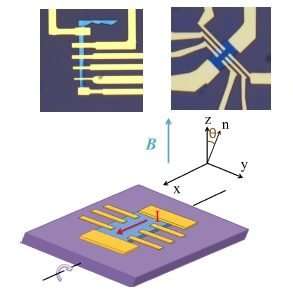Why 2-D? Measuring thickness-dependent electronic properties

Constraining the movement of charge carriers (electrons or holes) to two dimensions unlocks unusual quantum properties, resulting in useful electronic properties.
Although we refer to the layers within such materials as '2-D', they are not strictly two dimensional. What's key is the restriction of a particle's movement perpendicular to the plane of the material a scale that is proportional to the de Broglie wavelength of the particle.
In essence, this means the range from a few hundred nanometres down to a few nanometres.
Much can be learned by observing precisely at what thickness such new effects emerge.
A FLEET study published last week in Physical Review B quantifies the precise transition point in the promising material tungsten ditelluride (WTe2).
Measurements found:
- WTe2 thin films cross from 3-D to 2-D electronic systems at thickness of ~ 20 nm
- overlap between conduction and valence bands decrease at thickness below ~12 nm, implying that even thinner samples might achieve a bandgap.
The study began under FLEET CI Xiaolin Wang at the University of Wollongong, with FLEET Research Fellow Dr. Feixiang Xiang first studying the special electronic structure of bulk WTe2 samples that leads to the material's very large magnetoresistance (previously published).
Feixiang then prepared thin films of different thickness cleaved from a single crystal using micro-exfoliation onto a substrate.
After study of WTe2 thin films at UOW, Feixiang used UNSW laboratories to fabricate the devices from thin-film samples and perform transport measurements using ultralow temperature and high magnetic field measurement facilities.
Alignment markers, electrodes, and bonding pads were fabricated by E-beam lithography.
Angle-dependent quantum oscillation measurements were performed in very high magnetic fields at FLEET CI Alex Hamilton's lab at UNSW, revealing how the material's band structure changed with decreasing thickness, with a 3-D–2-D crossover when the sample thickness was reduced below 26 nm.
"This finding was very important," says Feixiang Xiang, who led the study at both UOW and UNSW, "because it pins down two critical length scales of the thickness-dependent electronic structure in WTe2 thin films."
Analysis indicated that the area of Fermi pockets decreases in thinner samples, suggesting the overlap between the conduction band and valence band becoming smaller. This not only explains the measured decrease of carrier density in a thinner sample, it suggests it is possible to open a band gap and realize the 2-D topological insulator in even thin samples, as has been predicted by theory, and observed in related compounds (MoS2 and MoTe2).
Tungsten ditelluride (WTe2) is a layered, transition metal dichalcogenide with several promising properties:
- extremely large magnetoresistance, with potential for use in magnetic sensors
- bulk WTe2 predicted to be a type-II Weyl semimetal
- monolayer WTe2 is a high temperature topological insulator, a superconductor, and a ferroelectric.
Transition metal dichalcogenides (TMDs) are a class of van der Waals materials, comprising many atomically-thin atomic layers bound by weak intermolecular forces.
We refer to TMDs as '2-D' because of this layered crystal structure.
Constraining the movement of charge carriers to two dimensions results in very different electronic properties compared to 3-D 'bulk' materials, which also suggests that more, different physical properties could happen at the monolayer limit – the transition point from 3-D to 2-D.
The study Thickness dependent electronic structure in WTe2 thin films was published in the American Physical Society's journal Physical Review B in July 2018.
More information: Fei-Xiang Xiang et al. Thickness-dependent electronic structure in WTe2 thin films, Physical Review B (2018). DOI: 10.1103/PhysRevB.98.035115
Journal information: Physical Review B
Provided by FLEET



















